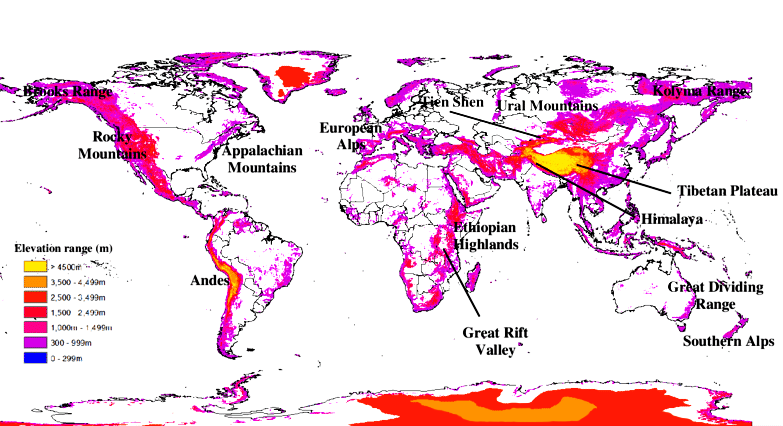Q. Briefly mention the alignment of major mountain ranges of the world and explain their impact on local weather conditions, with examples. (250 words)
07 Mar, 2022 GS Paper 1 GeographyApproach
- Briefly define the mountain ranges and its characteristics.
- Draw a world map mentioning the alignment of mountain ranges of the world.
- Mention some of the important mountain ranges of the word and its climate influence on local weather and climate.
- Conclude the answer suitably.
Introduction
- Mountain range refers to a series of ridges which originated in the same age and underwent the same processes.
- The most prominent or characteristic feature of mountain ranges is their long and narrow extension.
Mountain Ranges and its Climatic Influence
- Andes Mountain Range (7,000 km): The range stretches from north to south through seven countries in South America, along the west coast of the continent: Venezuela, Colombia, Ecuador, Peru, Bolivia, Chile, and Argentina.
- Because the Andes act as a large wall between the Pacific Ocean and the continent, they have a tremendous impact on climate in the region.
- The northern part of the Andes is typically rainy and warm, and the weather is also wet in the eastern part of central Andes, and the area to the southwest.
- To the west, the dry climate is dominated by the Atacama Desert in northern Chile.
- The mountains form a rain cover over the eastern plains of Argentina, which have extremely dry weather.
- Because the Andes act as a large wall between the Pacific Ocean and the continent, they have a tremendous impact on climate in the region.
- The Himalayas (2,400 km): The mountain range in Asia separating the plains of the Indian subcontinent from the Tibetan Plateau. The range has some of the planet's highest peaks, including the highest, Mount Everest.
- The Himalayas have a profound effect on the climate of the Indian subcontinent and the Tibetan Plateau.
- They prevent frigid, dry winds from blowing south into the subcontinent, which keeps South Asia much warmer than corresponding temperate regions in the other continents.
- Rockies Mountain Range (4,830 km): These mountains are massive mountain ranges that stretch from Canada to central New Mexico.
- The Rocky Mountains cast a fairly substantial rain shadow - a dry area on the leeward side of the mountain range, where wind does not hit, which forms because the mountains block rain-producing weather systems and create a metaphorical shadow of dryness.
- Essentially, the rain shadow is a desert forced into existence because of the mountain range it borders, which prevents the eastern slopes and foothills from experiencing the same moisture that falls on the western side of the range.
- Great Dividing Range (3,500 km): It runs roughly parallel to the east coast of Australia and forms the fifth-longest land-based mountain chain in the world, and the longest entirely within a single country.
- The Great Dividing Range blocks the flow of moist air coming from the Tasman Sea. This creates rain over the range and reduces the amount of rainfall in inland regions west of the range.
- The Atlas Mountains (2,500 km): The Atlas Mountains extend some 2,500km across northwestern Africa, spanning Morocco, Algeria and Tunisia. The mountain range separates the Mediterranean and Atlantic coastlines from the Sahara Desert.
- Westerly winds from the Atlantic Ocean carry moisture into the region, but the mountains act as a weather barrier between the coastal grasslands and wetlands and the Sahara Desert.
- The Atlas Range causes a rain shadow effect, preventing the areas beyond the mountains from receiving much rainfall. During the winter months, the highest peaks of the Atlas Mountains are among the few parts of Africa to see snow.
- The Ural Mountains (2,500 km): It extends from the Kara Sea to the Kazakh Steppe along the border of Kazakhstan. Geographically this range marks the northern part of the border between Europe and Asia.
- The northern side of the mountain range receives cool, rainy weather, while the southern side is a hot desert.
- The western side of the mountain range receives warm continental winds, while the eastern side is much cooler and drier.
- The Alps Ranges (1,200 km): The Alps are the highest and most extensive mountain range system that lie in south-central Europe.
- The mountain range stretches approximately 750 miles (1,200 kilometers) in a crescent shape across eight Alpine countries: France, Switzerland, Monaco, Italy, Liechtenstein, Austria, Germany, and Slovenia.
Conclusion
- The mountain ranges of the world provide essential ecosystem based services to global communities as well as inspiration and enjoyment to millions.
- These are particularly important for their biodiversity, water, clean air, research, cultural diversity, leisure, landscape and spiritual values.
- They are income sources for communities through agriculture, tourism and use of natural resources.
